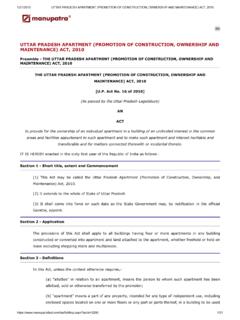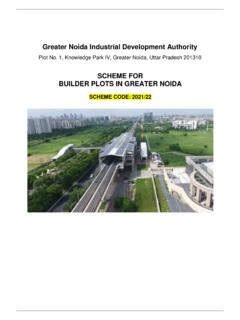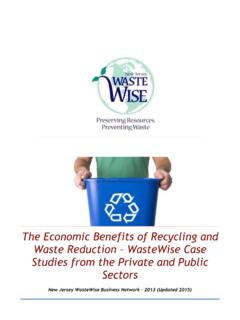Transcription of CONSTRUCTION AND DEMOLITION WASTE - 2019
1 1 GINDA CITY POLICY ON CONSTRUCTION AND DEMOLITION WASTE - 2019 GREATER NOIDA DEVELOPMENT AUTHORITY UTTAR PRADESH (Prepared in compliance of Rule 9 sub-rule 1 of C & D WASTE Management Rules, 2016) 2 Table of Contents 1. Background .. 3 2. Vision .. 4 3. Goal .. 4 4. The policy specifically endorses the following core principles: .. 4 5. Objectives: .. 4 6. Duties of Service Provider and Their Contractors .. 6 7. Duties of Local Authority: .. 7 8. Duties of the WASTE Generator: .. 8 10. Criteria for site selection for storage and processing or recycling facilities for CONSTRUCTION and DEMOLITION WASTE : .. 9 11. On Legislation and Institutional Arrangements.
2 10 12. On Standards, Regulations and Quality Assurance .. 10 13. Public Awareness: .. 10 14. How the Policy will be executed in the Cities/Towns: .. 10 15. C&D WASTE Processing Flow Chart: .. 11 16. Monitoring & Evaluation: .. 11 17. Tax Incentive .. 11 18. Capacity Building & Training .. 12 19. Expected Outcomes .. 12 3 1. Background It is very common to see huge piles of CONSTRUCTION and DEMOLITION (C&D) WASTE stacked alongside of major roads resulting in traffic jams, congestion and disruption & chocking of drains. It is one of the heaviest and most voluminous WASTE streams generated in the present scenario. Around 25% - 30% of all WASTE generated in the country comprises of C&D WASTE in developed countries.
3 CONSTRUCTION and DEMOLITION (C&D) WASTE is generated from CONSTRUCTION , renovation, repair, and DEMOLITION of houses, large building structures, roads, bridges, piers and dams etc. C&D materials included in this document are steel, wood products, drywall and plaster, brick and clay tile, asphalt shingles, concrete, and asphalt concrete. These estimates represent C&D material amounts from CONSTRUCTION , renovation and DEMOLITION activities for buildings, roads and bridges, and other structures. First of all, many of the materials used in the CONSTRUCTION of buildings are produced in a non-sustainable way. The factories that make these materials, causing harmful CO2 emissions.
4 There is a huge environmental impact associated with the extraction and consumption of raw materials for production of building materials. As per the study conducted by Centre for Science and Environment of India, a new CONSTRUCTION generates 40-60 kg of C&D WASTE per sqmt, then taking an average of 50 kg per sqmt, building repair produces 40-50 kg per sqmt of WASTE . The WASTE produced per sqmt of DEMOLITION is 10 times that generated during CONSTRUCTION . As per Technology Information Forecasting and Assessment Council (TIFAC), considering 300-500 kg of WASTE generation per sqmt, India must have generated about 50 million tons (MT) of C&D WASTE in 2013.
5 Typical composition of Indian C & D WASTE (TIFAC) # Material Composition 1 Soil, Sand & Gravel 36% 2 Brick & Masonry 31% 3 Concrete 23% 4 Metals 5% 5 Bitumen 2% 6 Wood 2% 7 Others 1% 4 2. Vision Greater Noida Industrial Development Authority to achieve the scientific management of C&D WASTE as per guidelines mentioned in the CONSTRUCTION & DEMOLITION (C&D) WASTE Management Rules, 2016. 3. Goal To effectively use the CONSTRUCTION and DEMOLITION WASTE in the state by scientifically manage all the C&D WASTE of the state to achieve 3 E s. i. Save Environment: Reduce air, water & noise pollution, health hazard etc. ii. Save Energy: Energy consumed in the production of the CONSTRUCTION material from natural resources.
6 Iii. Enhance Economy: Potential high value of recycled material not tapped and gets buried in landfills or illegal dumps leading to economic loss. Reduce demand-supply gap in these sectors and save the natural resources. Reduce the valuable WASTE going to landfill. 4. The policy specifically endorses the following core principles: i. To protect the environment and the City valuable land resources ii. Treatment of C&D WASTE at the local level so that value addition is done to the WASTE iii. Promoting use of the C&D WASTE at the city level and recycle & reuse of the WASTE for CONSTRUCTION , land filling and other uses. iv. To make the recycling of C&D WASTE at the residential, commercial and the institutional level, which is economical and environmentally sustainable.
7 V. Ensuring, protecting and proper use of the C&D WASTE . vi. Exploring Public Private Partnership (PPP) at the residential, commercial and the institutional level for C&D WASTE management and use. vii. Establishment of an efficient, effective, affordable and accountable system for managing the C&D WASTE , effective recycling and its reuse . 5. Objectives: To overcome the problem of collection, transportation and disposal of the C&D WASTE at the landfill site. The policy is drafted to ensure C&D WASTE is stored, collected, transported and processed properly so that it is put to effective use. The processing of the C&D WASTE is to reduce the burden of disposal as well as convert the C&D WASTE into meaningful product.
8 5 A. reduction of C&D WASTE : Less WASTE leads to fewer disposal facilities, which leads to less environmental issues. Rehabilitate an existing structure in place of planned DEMOLITION . Use deconstruction techniques rather than DEMOLITION of a building. B. reuse of C&D WASTE : It does not require any further processing to convert into a useful product. The items which are usable directly to be screened out from the debris and put into the possible use without further processing. C. Recycling of C&D WASTE : Once the WASTE generated from CONSTRUCTION and DEMOLITION activities has been segregated and reusable items are taken out, the leftover is available for further processing recycling into next useful stage.
9 D. Re-buy of processed material: Purchase recycled-content building materials by authorized contractor. In each new CONSTRUCTION 10% material (minimum) should be used recycled C&D WASTE materials. To ensure the above objective following activities should be followed: i. To ensure 100% collection of the C&D WASTE . ii. To ensure 100% processing of the C&D WASTE in the city. iii. To improve the environment and reduce the pressure on the landfill sites, water bodies, roadside or elsewhere in the city. iv. To ensure the C&D WASTE recycled is used for meaningful purpose in CONSTRUCTION , road, filling etc. v. To reduce the dependence upon the fresh CONSTRUCTION material at the local level.
10 Vi. To ensure alternative use of C&D WASTE material in the city. vii. Recycling of aggregate material from CONSTRUCTION and DEMOLITION WASTE . Storage, Collection and Transportation of C&D WASTE : C&D WASTE should be kept in the generator s compound in a properly segregated way and then transported to designated disposal sites prescribed by the local authority. Local authority will formalize a collection system with adequate tracking, monitoring. To create a framework for organized storage, collection, reuse or disposal WASTE generated. The C&D WASTE should be transported to the designated location/s on self-arrangements by generators or through other systems provided by ULB, whichever is mentioned in the by-laws of the ULB.









